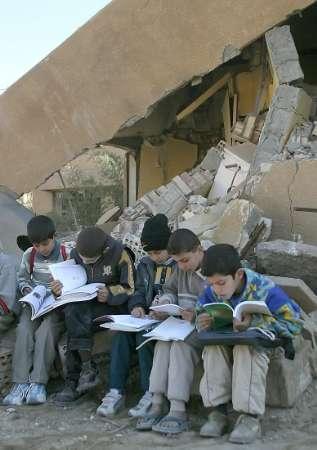Untitled Document

June 6, 2005
Six months after the U.S. war on Falluja, many residents still live in refugee
camps and students attend classes in tents.
Many school buildings, like almost everything else in the city, are heaps of
ruin. They are without walls, doors or windows – the outcome of U.S. bombardment
and aggression.
It is still hard to enter the city, as visitors must pass through U.S. checkpoints
that utilize high-tech equipment to try and scrutinize anyone entering or leaving.
I was standing in a long queue at the al-Jisir Entrance. Many students were
waiting to enter the city. “Everyday we wait here for at least one hour.
The city is under a curfew which ends at 8:00 a.m. U.S. troops are not nice.
They try to humiliate us,” said Kahlil al-Talib, a high school student.
Another, who spoke on condition of anonymity, said U.S. troops subject everyone
to “intensive scrutiny” before allowing people to pass. “We
are insulted and humiliated by them (U.S. troops). You can be checked several
times before entering the city,” he said.
Thousands of students in the nearby towns and villages attend high school in
the city. “There is no high school in our town, and Falluja is the closest
to us. Still, I must walk 4 kilometers to reach the checkpoint, where I am made
to wait for over an hour. By the time I reach the new tent school, classes have
already started,” he added.
Kareem Abdulhussein, head of the city’s teachers union, denied reports
that the city was being rebuilt with U.S. money. “There are no serious
efforts taking place to reconstruct the city and its schools. Contractors receive
huge amounts of money but nothing is done,” he said.
Once inside the city, I traveled to the al-Shuhada district, the scene of some
of the most ferocious fighting in the November 2004 U.S. onslaught. The schools
in this area were all destroyed. I asked what had happened to the students,
and a resident pointed to a partially damaged mosque nearby, where scores of
tents were pitched.
“Our school was leveled. We use a room in the mosque for administration
and have classes in tents,” said Ibrahim Sarhan, the principal of the
al-Bab School.
Karima Hassan said she tries her best to conduct classes inside the mosque
for her all-girl Mafakhir School. The school was also destroyed.
I then headed to Hay al-Julan where I saw two more destroyed school buildings.
In the northern part of the city, there was less destruction. Residents said
that the fighting in the area was “less severe” than in other quarters,
but still the school buildings there had sustained heavy damage.
It is not clear why the city’s schools have borne the brunt of such overwhelming
damage. I counted 65 school buildings that were heavily damaged or completely
destroyed.
Falluja is still a ghost town because little has been done to undo the damage
inflicted by U.S. forces. Officials say of the 30,000 homes that were damaged
and nearly 5,000 that were completely destroyed; only a few have been repaired.
In addition, very little has been done to repair the 8,500 businesses, 60 mosques
and 20 government offices that were damaged.
“The situation is extremely bad,” said Abdulla Saleh, a senior
education official in the city.
He said that the few schools that survived the fighting were still occupied
by either U.S. or Iraqi forces.

